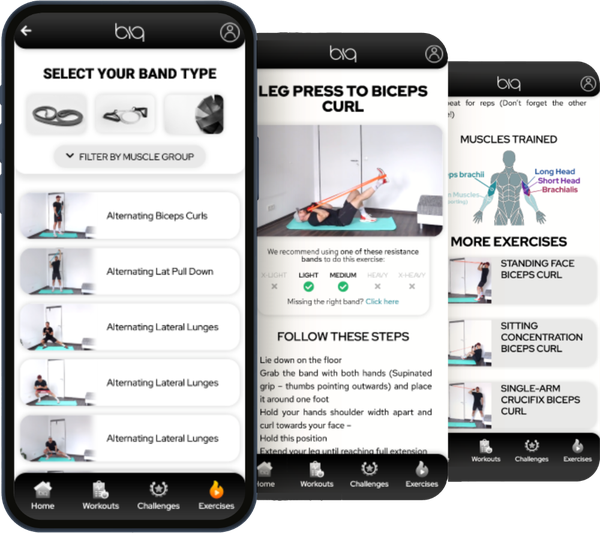This is my most favorite isolation exercise for the triceps, period. And I am quite sure that you will grow to love it too. The triceps overhead extension will really challenge your triceps and help you reach your arm goals, whatever they might be. You want to build muscle mass and/or strength? You want to get slimmer and firmer arms? The answer is: incorporate triceps extensions in your workouts, and you will head in the right direction.
Doing direct isolation training for your triceps will also greatly benefit your compound pressing movements, like chest and shoulder presses. And I have even more amazing news for you: you can perform triceps overhead extensions by using resistance bands anywhere and work your triceps effectively. Actually, I even feel my triceps working much more when I use resistance bands compared to weights.
You will be needing at least one resistance band to get started. But we highly recommend getting a set with different resistance levels from the start (like this one: Resistance Bands Set). This way you can get a lighter or stronger band depending on the exercise and muscle. This will help you drastically to make progress and see results.
In this article, we will show you how to perform a perfect triceps overhead extension with resistance bands. But we don’t stop there. You will learn what form mistakes to avoid and how to adjust the resistance of a band to get it just right. We have look at different variations (spoiler: there is quite a number) and discuss which muscles are mainly used in this exercise. We finish it off by how to incorporate tri extensions in a workout program. Let’s jump right into it!
How To Do Triceps Overhead Extensions The Right Way With Resistance Bands?
I know I promised you that we will jump straight into the exercise… I lied. But I had a good reason. Way too often, people get small or sometimes even bigger injuries because the warm-up was skipped. I really don’t want you to be one of these people. A simply and quick warm-up session will get your body ready for resistance training and will result in making way quicker progress in the long run. A reminder: quicker progress means quicker seeing results.
All right, now let’s get started. What equipment will you need? We already mentioned the resistance band – no surprise here anyway. The second piece will be a Door Anchor. We will have a look at variations without using a door anchor in a later section, but the one with the door anchor is actually way more beneficial.
The last thing is optional but highly recommend: Workout Gloves. Holding resistance bands in your hands and stretching them will result in friction on your skin. Having gloves on will protect your hands.
Ok, equipment – check. Next question: What do I actually have to do?
By performing the following 6 steps, you will get your first perfect tri extension. However, don’t forget to have a look at the next section, where we will show you what mistakes are common and how to avoid doing them.
- Attach the band towards the bottom of a door with a door anchor
- Grab the band and bring your arms over your head, so your elbows point upwards
- Get into a slit stance position and step forward until you have tension in the band
- Extend your arms up at a slight angle until fully extended
- Return slowly to the starting position (resist against the pull of the band)
- Repeat for reps
Form Mistakes To Avoid
⓵ Neutral Neck – one of the most common mistakes is sticking your head forward. Keep your neck in a neutral position aligned with your upper body. This will ensure that you have a good form and will prevent any peak stress in your neck. The cause is usually a load which is too high. The body tries to compensate the lagging strength in the triceps by getting into a position where more muscles can be activated to move the load. But we don’t want any other muscles to be active. A good practice to prevent the head from going forward is sticking your chest out and rotating the shoulders back.

⓶ Lock the Elbows in Place – to really isolate the triceps, it is important that the elbows don’t move. After getting your arms into the starting position, lock the elbows in place and focus on not swinging them with each repetition. If you move the elbows, the exercise becomes easier because other muscles will be involved. However, your goal is to isolate the triceps with this exercise.
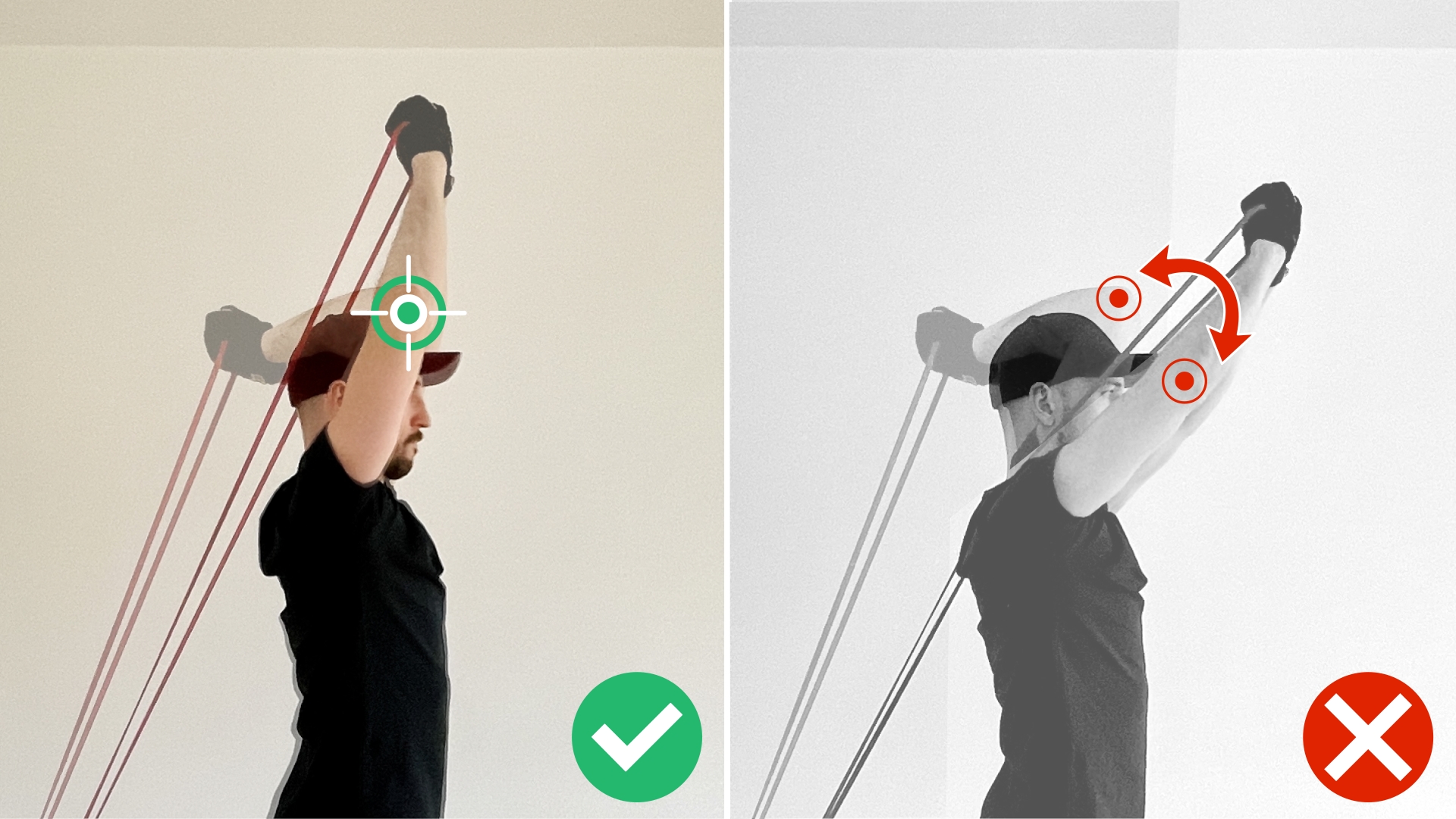
⓷ Controlled Reps and Full ROM – being in control of the movement is the best way to avoid injuries, make the exercise much more effective and make faster progress. Don’t let the band do the work, especially in the negative part of the exercise, where you lower your hands. This is actually the most effective part!
Also perform the extension through the full range of motion (ROM). This means no partial repetitions. Extend the arm fully and lock your elbows in the top position. Lower your hands until your forearms touch the biceps in the bottom position.

Internalize these form guidelines, and you will have a much more superior triceps overhead extensions in your arsenal. Besides the tri extension specific mistakes to eliminate, there are some more general points to know when it comes to training with resistance bands. Find out more here: The Worst Mistakes You Can Do When Training With Resistance Bands
How To Adjust The Resistance
In contrary to weight where you have a fixed resistance, a resistance band has a variable resistance. This means one band can be very light to stretch and really difficult depending on the setup. Basically, the further you stretch a band, the more pull it will generate. This also means that using a heavier resistance band when you become slightly stronger and the movement get easier, is usually not the correct move. First, you should use the full potential of the current band and only after transition to the next thicker one.
The best methods to adjust the resistance for triceps overhead extensions are:
Changing the Distance to Anchor point – This is the reason we gave you the door anchor variation as the standard version of the tri extensions. With this setup, you are able to change the resistance by taking a step away or towards the anchor point. It will result in more (step forward) or less (step backwards) stretch in the band in the starting and end positions of the exercise, which will change the resistance accordingly. The best thing is that you can make this change in the middle of a set. Start with a higher distance to the anchor point and challenge yourself by doing a couple of really hard repetitions. Then take a small step back and do a couple more. Take another step back… You get the idea.
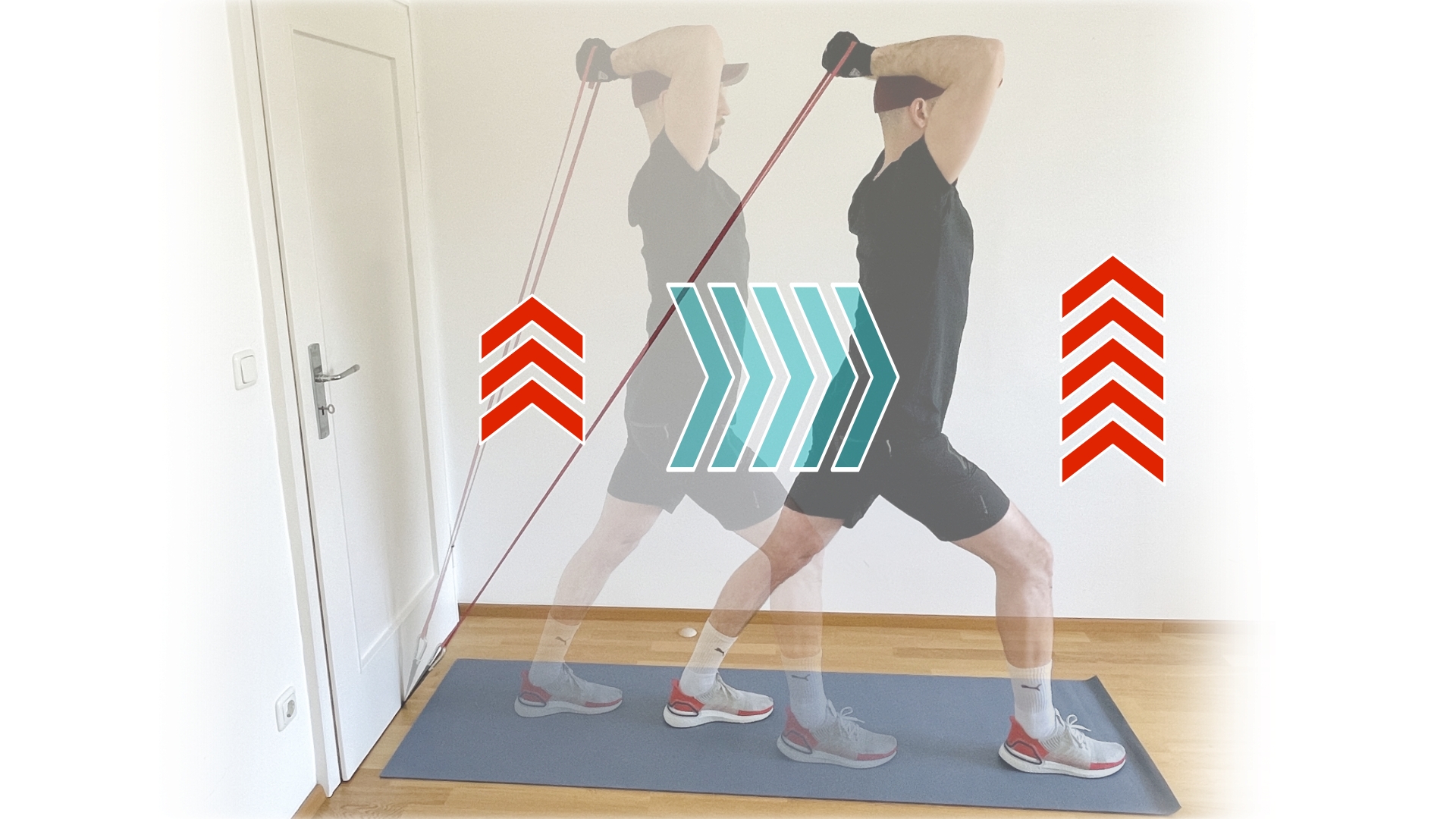
Adding a second band – Having a set of bands with different resistance levels will allow you to use this method. By combining two (or more) bands of different thickness, you can create the right resistance for the job. I use this method like this: If I feel like it is time to increase the resistance, I grab the lightest band in the set and add to the current band I use. This will increase the resistance slightly without taking it over the edge.
Slowing it down – This is actually one of the most effective ways to break through any plateaus, but often not used. You can increase the intensity without increasing the resistance by performing the movement at a slower speed. This will result in a higher total time under tension and therefore in more work for your muscles.
Combining Methods – This is only a little reminder. You can mix and match the methods of adjusting the resistance/intensity we had a look at so far. This will give you a lot of freedom and will make your use of resistance bands much more effective.
The BIQ App
Take training with resistance bands to the next level with our free app.
- 800+ Exercises
- all band types
- different training goals & workouts
- challenges
- much more
Alternative Ways To Do Triceps Overhead Extensions With Resistance Bands
I promised you heaps of variations for the tri extension, and I always keep my word. Exercise variations are great to keep your body guessing and prevent it from getting used to a movement pattern. By changing up your routine on a regular basis, you keep the training interesting and engaging as well. This helps a lot to stay consistent.
Triceps Overhead Extension (no Door Anchor) – In case you don’t have a door anchor at hand, this variation makes overhead extensions still possible. To start, step on the band with both feet and have the band in front of you. Grab the band with both hands and bring them from here to your chest and press them over your head. This basically brings you in the top position of the tri extension. Lock your elbows in place, lower your hands and start doing reps.
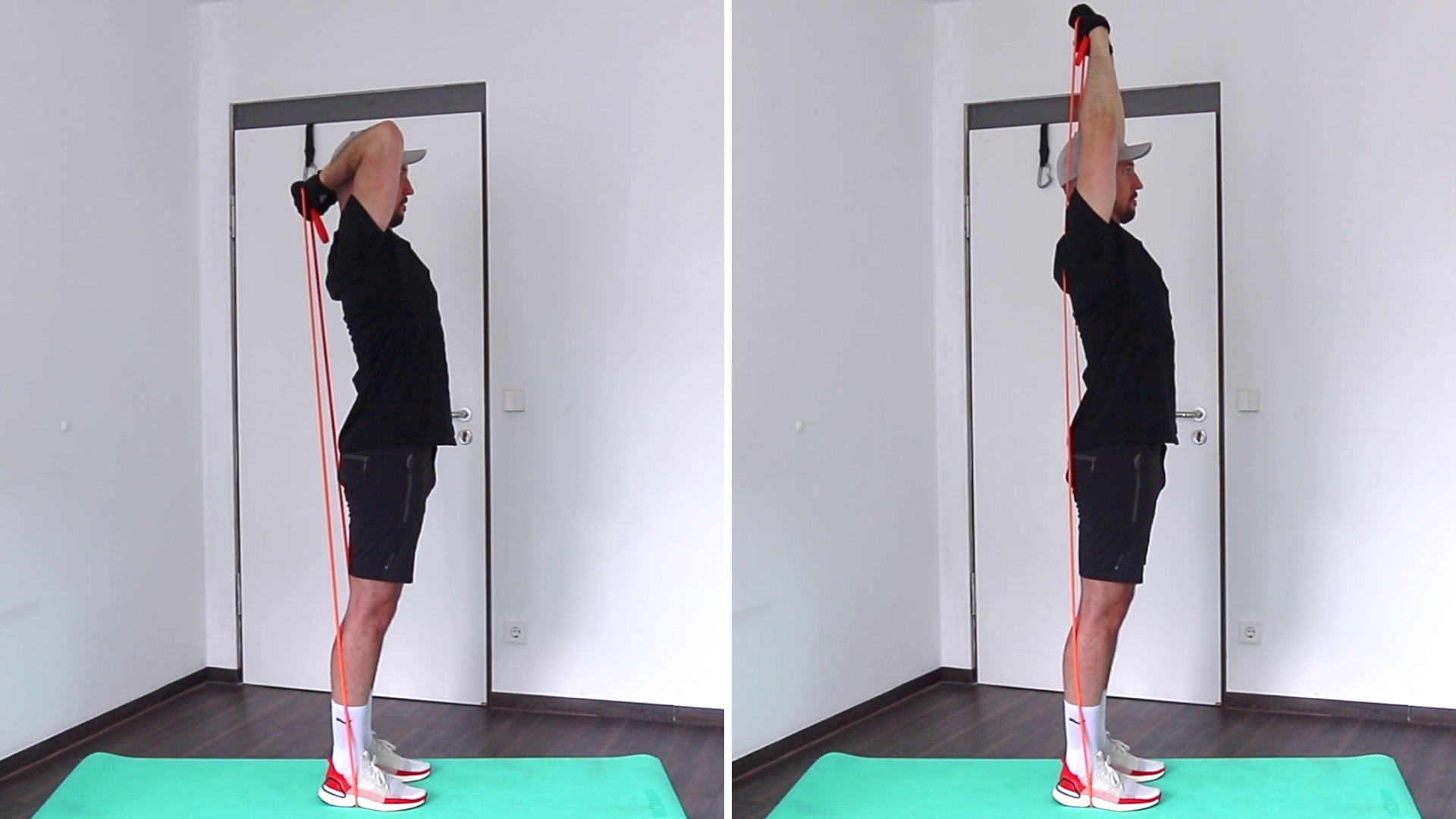
High Anchored Triceps Overhead Extension – the high anchored variation makes setting up the exercise a little easier. The disadvantage is that you will have to counter the pull of the band by having a more stable stance, to not get pulled backwards.
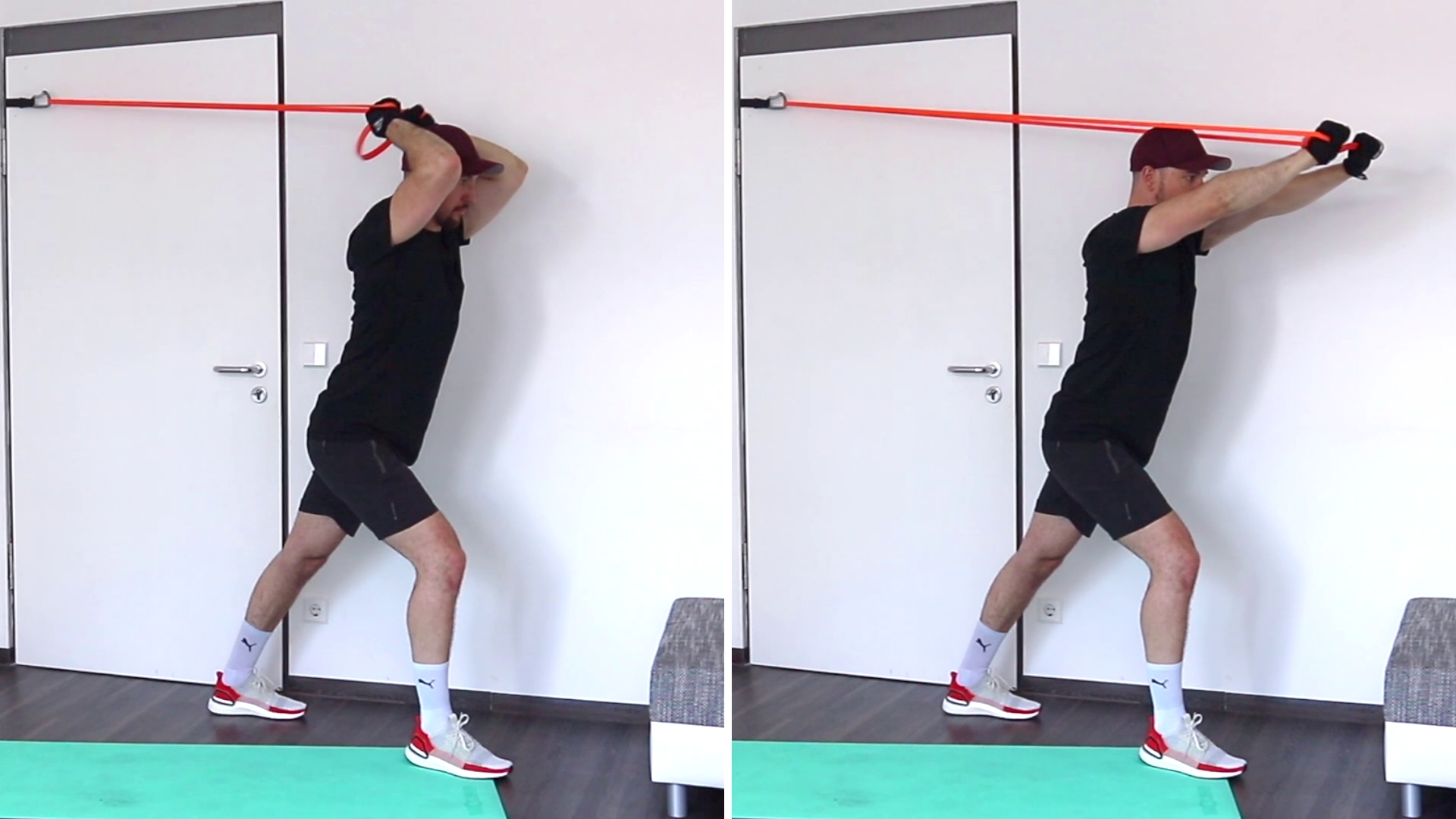
Triceps Side Extension – resistance bands give you the possibility of doing very unique extension variations as well. The triceps side extension is great if the overhead elbow position is not really your thing. Make sure that you have tension in the band in the start position.
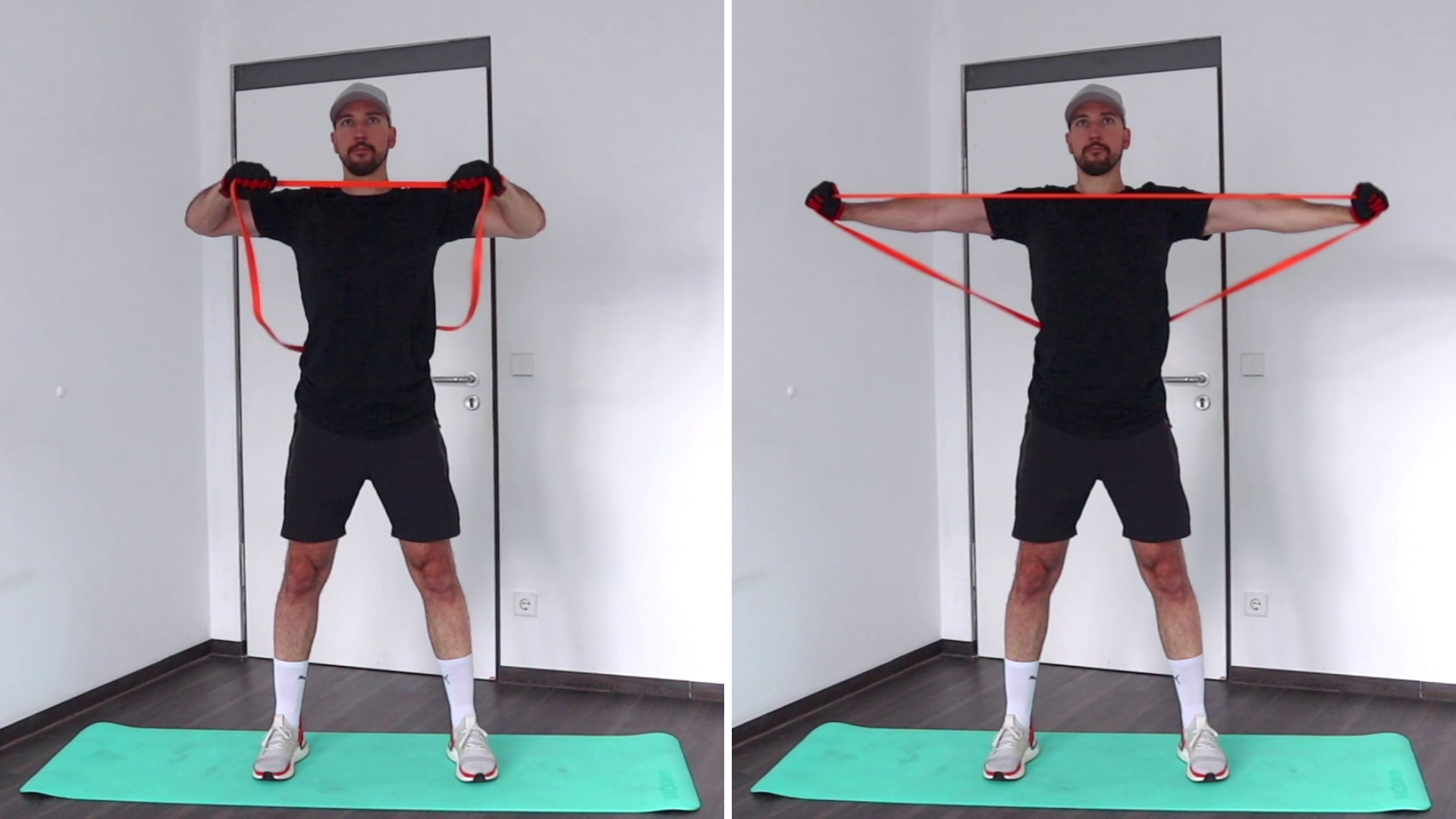
Triceps Forward Extension – the forward extensions are great if you’re just starting out with resistance training. This variation will require the least amount of flexibility and setting up. Get yourself inside the loop, place the band on your upper back and grab it, so there is tension in the starting position. Now extend your arms forward until fully extended.
Unilateral Triceps Extension – the unilateral version is great to put the full focus on one side at a time. Also, it is the way to go if you are working on fixing any imbalances between the right and left side of your body. Since you have to stretch both strings of the band with one arm, use a much lighter band. Of course, you can do the single arm version for all variations you have seen so far.
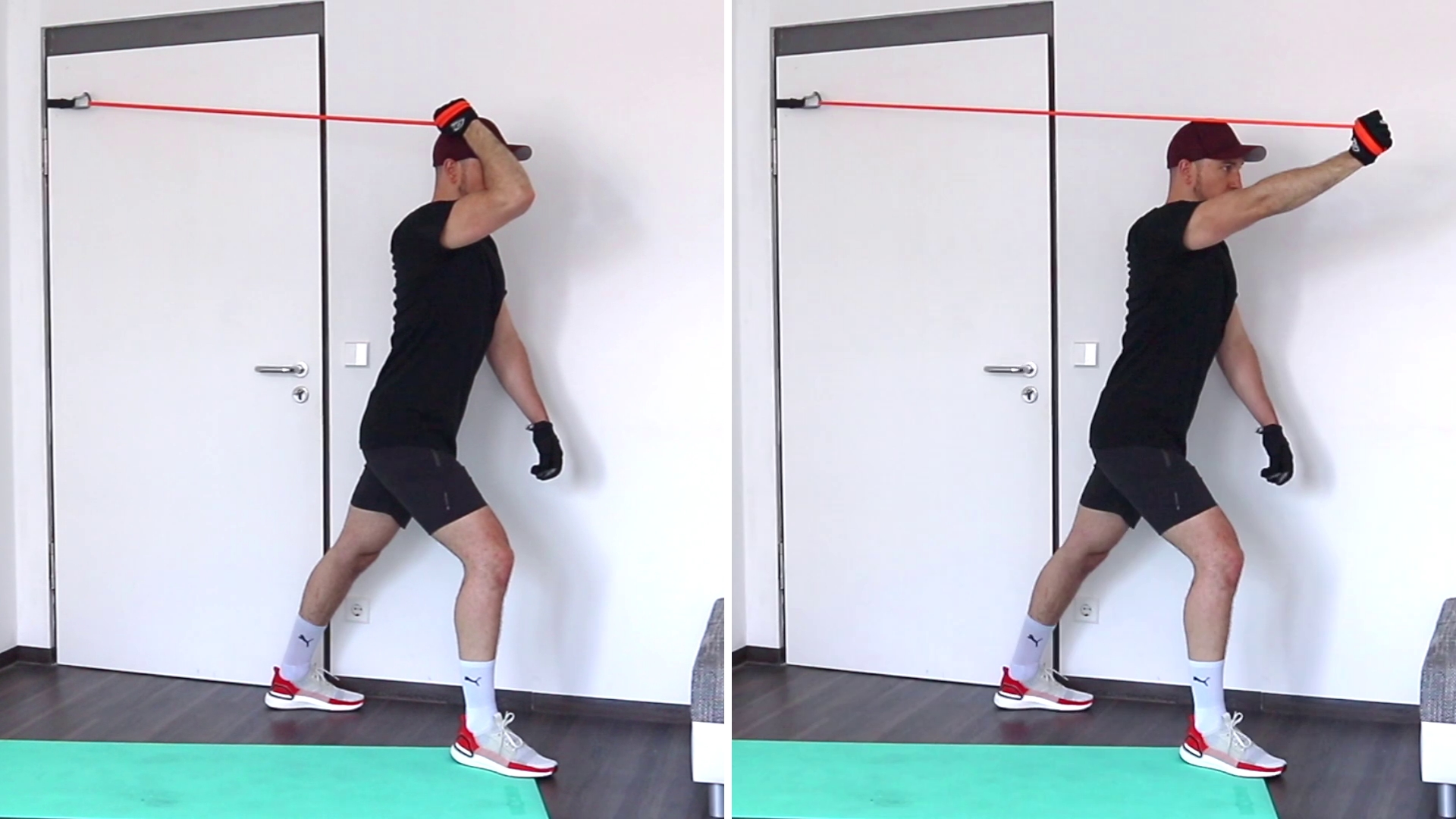
Can You Train Your Triceps Effectively With Resistance Bands?
The usual approach to effective triceps training is going to the gym and using the cable machine. This way you can create the angles which make the exercises more efficient. Without using cables, triceps training get way more complicated. This is even more a reality if you don’t want to train at a gym and rather do your workouts at home or outside. This is where resistance bands fill the gap. You will be able to do the same exercises as by using cable machines, simply by anchoring the band. In addition, resistance bands can generate more than enough tension to stimulate your triceps. And all this without spending heaps of money on a gym membership or equipment for your home.
Why Does Training With Resistance Bands Work
The reason is actually quite straight, forward. You know that there is a difference between a dumbbell and a resistance band, because they look different. But your muscles don’t have eyes. All they know is resistance. And by moving muscles against a load, you will give your body the signal to build muscles and strength. Therefore, you can do your resistance training by using traditional ways like weights or try bands and reap various benefits.
If you want to learn more about this topic – read our full article: Why Does Training With Resistance Bands Work
Benefits Of Training With Resistance Bands
Using bands for resistance training is quite beneficial in a lot of ways when it comes to triceps exercises. Some are:
- Strength Curve! The further you stretch a band, the more resistance it will generate. This is called linear variable resistance. This matches the natural strength curve of your triceps. The more you extend your arm, the more load you can handle.
- No Cheating! Using momentum when training with weights is quite common, bands prevent this unconscious cheating due to their resistance curve.
- Joint Health! Less resistance in weaker angles of your arms also results in less stress on the joints and therefore in less risk of injury or overuse.
- Mobile and Versatile! Resistance bands fit in any bag and can be brought along anywhere. In addition, they make it possible to do exercise which are only possible by using cable machines.
Don’t have enough? No worries, there are even more benefits. Get a full grasp by having a look at the following article: Benefits Of Resistance Band Training
What Muscles Are Used In A Resistance Band Triceps Overhead Extension
I don’t think you will be surprised if I tell you that the main working muscles in this exercise is the triceps. The fancy anatomic name is Triceps Brachii, which stand for “the 3-headed muscle”. This is a hint to the fact that there are 3 distinct regions of the triceps, and they are called heads. There are quite a some exercises for training your triceps, and most of the other exercises will have a major focus on the lateral or the medial head. The long head is heavily active if the elbows are in front of your body in the extension movement. This is the case with the overhead extensions.
Main Working Muscles:
- Triceps Brachii
Main Working Tricep Heads:
- Long Head
Workout Routine
Today you added an excellent tricep exercise to your arsenal, congratulations! Keep on learning new exercises, how to do them correctly and some background stuff about resistance training, and in no time you will be very confident in your workouts. However, we want to emphasize that only doing a single exercise or only training your triceps is not the way to go. To really advance, actually reaching your goals and keeping the results, you will need some structure in your working out.
The best approach is having or getting a workout routine to follow. We started this whole thing right here because we were shocked and annoyed how much misinformation or half-truths are out there when it comes to training and especially training with resistance bands. To counter that, we started this website and developed an app which will be your secret weapon to success.
The BIQ Training App is basically your personal trainer. You will be able to generate a workout routine depending on your fitness goal, the equipment available to you and the time you have available in a week. The only thing you have to do after that, is follow along… I know – it is actually the hardest part 😉
Besides the workout routines, you will also find single workouts you can do at anytime, challenges to test yourself and a stuffed exercise library with all the important information.
Find out more here: BIQ Training App

